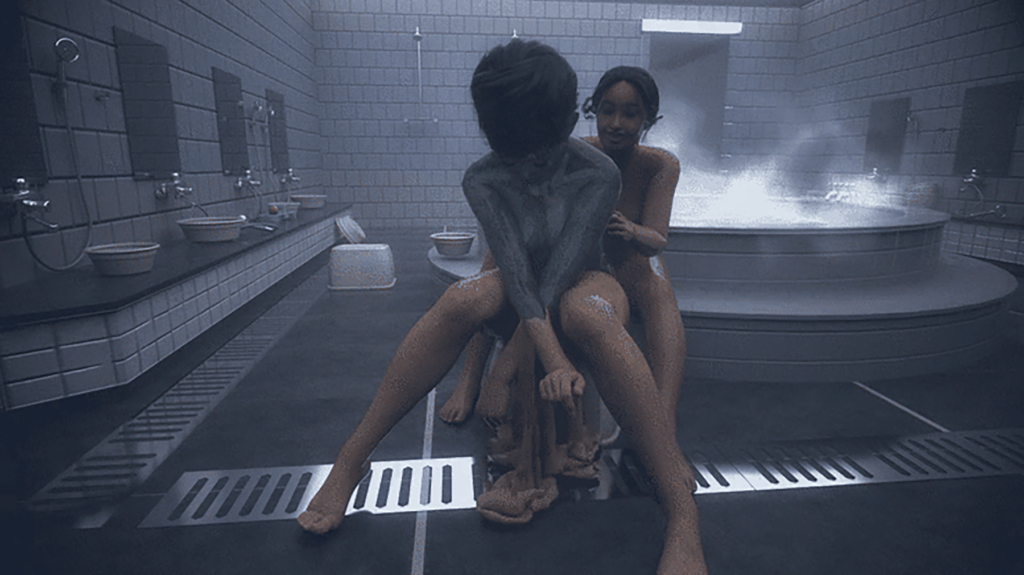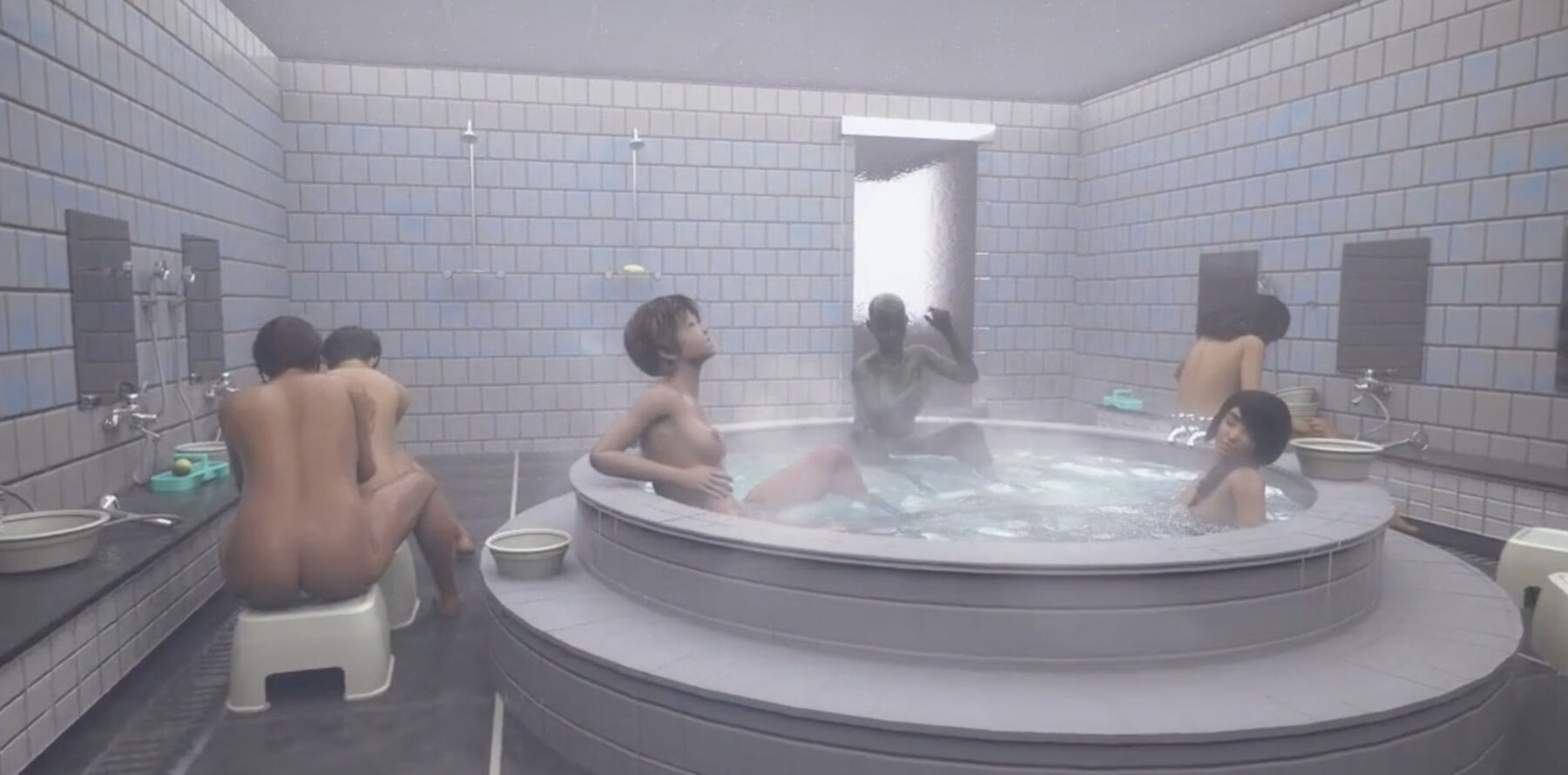Text by Katherine Jemima Hamilton

I first encountered Heesoo Kwon’s Leymusoom Universe in 2019 at her solo show Watertight Mesh in a basement gallery in San Francisco’s Chinatown. It was dark and a bit damp, though perhaps damp is a quality I retroactively ascribed to the scene because the long gallery was illuminated by a projected video featuring nude 3D-modeled avatars in a Korean spa. In the 5-minute looping video, the women—incarnations of Kwon’s female ancestors—grow and shrink in size, scrubbing and massaging each other in saunas and hot tubs. Coaxed by a serpent woman with taloned fingernails and a tail where you might search for her legs, the women trade their human flesh for scales like hers, exchanging dead skin cells for a renewed life.
A repetitive, rhythmic, tonal sound (but bada but bada but bada) accompanies the video, potentially maddening to the attendees ignorant of the sound’s origins: the drumming of traditional Korean ironing sticks, a metonym for a joyful life of women together in a stable household. Before I emerged from the basement, Heesoo herself (though I didn’t know it was her at the time) handed me a dark green face towel that commemorated the exhibition’s opening date, as though I was leaving a ritual or communion weighty enough to merit token souvenirs for safekeeping. Four years and two apartments later, the towel still hangs in my bedroom.
It wasn’t evident to me at the time that I had converted to Leymusoom that night. Still, after years of contemplating how Kwon’s practice could fit into or guide my own life, I have transformed my relationship with my female ancestors by contemplating how their centuries of choices (freely elected or driven by exploitation) shape my reality. Leymusoom manifests in multiplicity, but primarily, it is a feminist religion the artist initiated in 2017, founded on the universal rejection of patriarchy and misogyny.
Using her female ancestors (known and unknown) as the subject of the digital universe she has created through online archives, manipulated photos, online and IRL rituals, and animated videos stylized like hyperreal SIMs, Kwon seeks to liberate her mother, grandmother, great-grandmothers, and their mothers and grandmothers from the oppressive forces that shaped their lives on Earth.
These second lives Kwon gives her progenitors exemplify the experiences they could have chased were they free of shame or “women’s work.” When I took this towel home, I committed to not only participate in Leymusoom world-building—imagining the otherwise lives my female ancestors could have lived while wrapped in soft flesh—but embodying the choices they could have made by incorporating feminist pillars in my own present actions. In other words, I seek to liberate those who came before me by liberating myself.
Something else about Kwon’s practice stuck with me: the simultaneous tension and alignment between the spiritual and digital realms. Kwon’s capacity to radically re-imagine reality, to impossibly reform the past, required a space where bodies need not take shape in flesh, liquid, or dust—and she found it. Existing only inside Kwon’s collection of USB keys and hard drives, these alien worlds—arid as deserts and moist as the jungles—provide space for the women to move freely without the constraints of space and time that wear on bodies in our corporeal world. Kwon’s desktop monitors and USB drives speak to each other through 0s and 1s, relocating her to another place where the physics of Earth have collapsed—not to mention the absence of social contracts formed through thousands of years of human war and conceit.
On her choice to build her feminist utopia digitally, Kwon told me, the digital and spiritual worlds exist, but we actually don’t always see them in our physical space because we need to access them through some type of channel or medium. Korean shamans use a mirror to see the spiritual world; I use a computer monitor and hard drive to access the Leymusoom digital world.
So, there are different kinds of venues and portals you can experience and use to see these invisible worlds, but we mostly just intuit that they exist through small experiences of these realms’ energies. WIFI signals mirror the eerie presence in the corner of a room; the physical effects of screen time, such as eye strain or sleep deprivation, replicate a manifestation of the underworld.

To Kwon, the digital and spiritual realms are so cosmically linked that the malfunction or misplacement of a hard drive is akin to the passing of a loved one. While preparing for her solo show at the Institute of Contemporary Art San José in California, the artist’s D: drive was singed to ashes by a large and powerful computer, corrupting all the raw files she had prepared for her monumental video piece, Leymusoom Garden. I had used it since 2017, she reflected, meaning the D: drive dated back to the year the religion was founded.
When I lost all the raw data, it felt like I lost an actual human family member or a friend… She took the hardware to a repair shop, where the mechanic proclaimed that recovering the data would be like raising a body from beyond the grave: impossible, at least for the time being. Now the dead body is in one of the Onggi jars in the gallery, waiting for the future when there is access to better technology that can fix the drive so that I can read it again… Like a time capsule. The data waits to be recovered, to be reborn again.
Though Kwon often uses projected videos to bring her 3D-modeled ancestors into physical space, the Leymusoom Digital Universe, connected by cloud computing and wifi waves, gives context and history to Kwon’s hybrid practices. Like many digital worlds preceding Kwon’s [1], the Leymusoom Digital Universe is fertile ground for ongoing, limitless creation and provides a resting area for the incorporeal beings Kwon has resummoned when they are not on view.
The shrine offers a space between living and dead, physical and immaterial, flesh and apparition; for the figures we watch transform again and again through Kwon’s years of video animation. After entering the shrine with a few mouse clicks, we float above the artist’s ritual room, where she sits at her desk in Leymusoom serpent form, using her ceremonial devices to connect our carnal world of constructed sin to the incorporeal one of liberation. Kwon’s voice narrates a welcome message instructing the visitor on how to navigate this foreign land.
Move too far forward or back, and you leave the 3D-rendered apartment and enter a hazy green atmosphere that reveals the digital portal is situated inside a large black asteroid-looking vessel, floating peacefully among other asteroid rooms of the same universe. For Kwon, this digital landscape is not separated or severed entirely from the way physical reality operates—while invented and malleable, even technological utopia must conform to some law of physics.
The digital realm is definitely another kind of land, she told me, explaining why Leymusoom still follows some Earth-like laws. It’s not like something that does not exist and is fully imagined; it has a different sense of time and space; and my body… the relationship between my body and the land is definitely different from where I’m located here, in the physical world.
The Leymusoom world is a locatable territory like certain imaginings of heaven or hell. Cyborgian in nature, Leymusoom ancestors must experience the world from each perspective that moulded them. Despite being inorganic itself, the digital world was the most natural place to build a multi-modal hybrid life.






